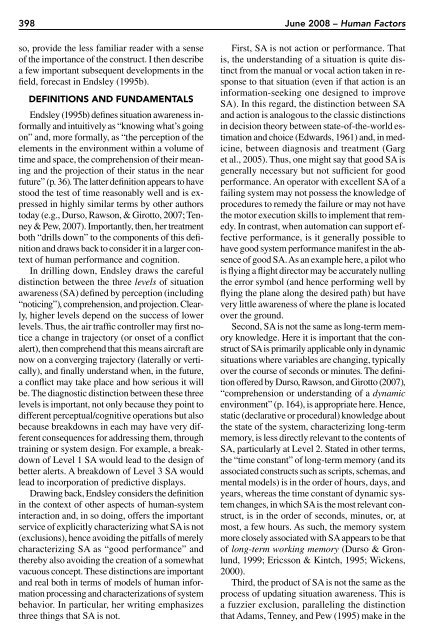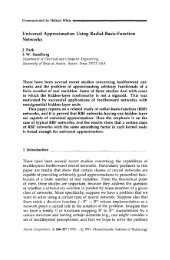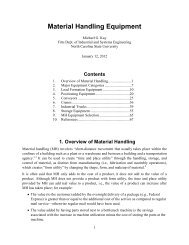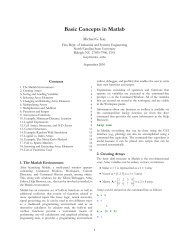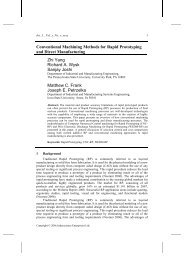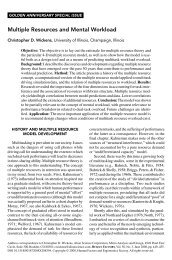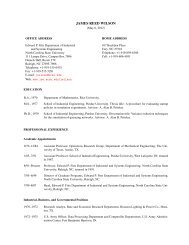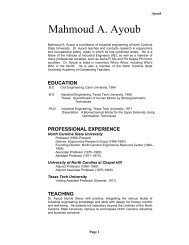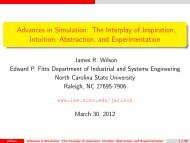Situation Awareness: Review of Mica Endsley's 1995 Articles on ...
Situation Awareness: Review of Mica Endsley's 1995 Articles on ...
Situation Awareness: Review of Mica Endsley's 1995 Articles on ...
Create successful ePaper yourself
Turn your PDF publications into a flip-book with our unique Google optimized e-Paper software.
398 June 2008 – Human Factors<br />
so, provide the less familiar reader with a sense<br />
<str<strong>on</strong>g>of</str<strong>on</strong>g> the importance <str<strong>on</strong>g>of</str<strong>on</strong>g> the c<strong>on</strong>struct. I then describe<br />
a few important subsequent developments in the<br />
field, forecast in Endsley (<str<strong>on</strong>g>1995</str<strong>on</strong>g>b).<br />
DEFINITIONS AND FUNDAMENTALS<br />
Endsley (<str<strong>on</strong>g>1995</str<strong>on</strong>g>b) defines situati<strong>on</strong> awareness informally<br />
and intuitively as “knowing what’s going<br />
<strong>on</strong>” and, more formally, as “the percepti<strong>on</strong> <str<strong>on</strong>g>of</str<strong>on</strong>g> the<br />
elements in the envir<strong>on</strong>ment within a volume <str<strong>on</strong>g>of</str<strong>on</strong>g><br />
time and space, the comprehensi<strong>on</strong> <str<strong>on</strong>g>of</str<strong>on</strong>g> their meaning<br />
and the projecti<strong>on</strong> <str<strong>on</strong>g>of</str<strong>on</strong>g> their status in the near<br />
future” (p. 36). The latter definiti<strong>on</strong> appears to have<br />
stood the test <str<strong>on</strong>g>of</str<strong>on</strong>g> time reas<strong>on</strong>ably well and is expressed<br />
in highly similar terms by other authors<br />
today (e.g., Durso, Raws<strong>on</strong>, & Girotto, 2007; Tenney<br />
& Pew, 2007). Importantly, then, her treatment<br />
both “drills down” to the comp<strong>on</strong>ents <str<strong>on</strong>g>of</str<strong>on</strong>g> this definiti<strong>on</strong><br />
and draws back to c<strong>on</strong>sider it in a larger c<strong>on</strong>text<br />
<str<strong>on</strong>g>of</str<strong>on</strong>g> human performance and cogniti<strong>on</strong>.<br />
In drilling down, Endsley draws the careful<br />
distincti<strong>on</strong> between the three levels <str<strong>on</strong>g>of</str<strong>on</strong>g> situati<strong>on</strong><br />
awareness (SA) defined by percepti<strong>on</strong> (including<br />
“noticing”), comprehensi<strong>on</strong>, and projecti<strong>on</strong>. Clearly,<br />
higher levels depend <strong>on</strong> the success <str<strong>on</strong>g>of</str<strong>on</strong>g> lower<br />
levels. Thus, the air traffic c<strong>on</strong>troller may first notice<br />
a change in trajectory (or <strong>on</strong>set <str<strong>on</strong>g>of</str<strong>on</strong>g> a c<strong>on</strong>flict<br />
alert), then comprehend that this means aircraft are<br />
now <strong>on</strong> a c<strong>on</strong>verging trajectory (laterally or vertically),<br />
and finally understand when, in the future,<br />
a c<strong>on</strong>flict may take place and how serious it will<br />
be. The diagnostic distincti<strong>on</strong> between these three<br />
levels is important, not <strong>on</strong>ly because they point to<br />
different perceptual/cognitive operati<strong>on</strong>s but also<br />
because breakdowns in each may have very different<br />
c<strong>on</strong>sequences for addressing them, through<br />
training or system design. For example, a breakdown<br />
<str<strong>on</strong>g>of</str<strong>on</strong>g> Level 1 SA would lead to the design <str<strong>on</strong>g>of</str<strong>on</strong>g><br />
better alerts. A breakdown <str<strong>on</strong>g>of</str<strong>on</strong>g> Level 3 SA would<br />
lead to incorporati<strong>on</strong> <str<strong>on</strong>g>of</str<strong>on</strong>g> predictive displays.<br />
Drawing back, Endsley c<strong>on</strong>siders the definiti<strong>on</strong><br />
in the c<strong>on</strong>text <str<strong>on</strong>g>of</str<strong>on</strong>g> other aspects <str<strong>on</strong>g>of</str<strong>on</strong>g> human-system<br />
interacti<strong>on</strong> and, in so doing, <str<strong>on</strong>g>of</str<strong>on</strong>g>fers the important<br />
service <str<strong>on</strong>g>of</str<strong>on</strong>g> explicitly characterizing what SAis not<br />
(exclusi<strong>on</strong>s), hence avoiding the pitfalls <str<strong>on</strong>g>of</str<strong>on</strong>g> merely<br />
characterizing SA as “good performance” and<br />
thereby also avoiding the creati<strong>on</strong> <str<strong>on</strong>g>of</str<strong>on</strong>g> a somewhat<br />
vacuous c<strong>on</strong>cept. These distincti<strong>on</strong>s are important<br />
and real both in terms <str<strong>on</strong>g>of</str<strong>on</strong>g> models <str<strong>on</strong>g>of</str<strong>on</strong>g> human informati<strong>on</strong><br />
processing and characterizati<strong>on</strong>s <str<strong>on</strong>g>of</str<strong>on</strong>g> system<br />
behavior. In particular, her writing emphasizes<br />
three things that SA is not.<br />
First, SA is not acti<strong>on</strong> or performance. That<br />
is, the understanding <str<strong>on</strong>g>of</str<strong>on</strong>g> a situati<strong>on</strong> is quite distinct<br />
from the manual or vocal acti<strong>on</strong> taken in resp<strong>on</strong>se<br />
to that situati<strong>on</strong> (even if that acti<strong>on</strong> is an<br />
informati<strong>on</strong>-seeking <strong>on</strong>e designed to improve<br />
SA). In this regard, the distincti<strong>on</strong> between SA<br />
and acti<strong>on</strong> is analogous to the classic distincti<strong>on</strong>s<br />
in decisi<strong>on</strong> theory between state-<str<strong>on</strong>g>of</str<strong>on</strong>g>-the-world estimati<strong>on</strong><br />
and choice (Edwards, 1961) and, in medicine,<br />
between diagnosis and treatment (Garg<br />
et al., 2005). Thus, <strong>on</strong>e might say that good SA is<br />
generally necessary but not sufficient for good<br />
performance. An operator with excellent SA <str<strong>on</strong>g>of</str<strong>on</strong>g> a<br />
failing system may not possess the knowledge <str<strong>on</strong>g>of</str<strong>on</strong>g><br />
procedures to remedy the failure or may not have<br />
the motor executi<strong>on</strong> skills to implement that remedy.<br />
In c<strong>on</strong>trast, when automati<strong>on</strong> can support effective<br />
performance, is it generally possible to<br />
have good system performance manifest in the absence<br />
<str<strong>on</strong>g>of</str<strong>on</strong>g> good SA. As an example here, a pilot who<br />
is flying a flight director may be accurately nulling<br />
the error symbol (and hence performing well by<br />
flying the plane al<strong>on</strong>g the desired path) but have<br />
very little awareness <str<strong>on</strong>g>of</str<strong>on</strong>g> where the plane is located<br />
over the ground.<br />
Sec<strong>on</strong>d, SAis not the same as l<strong>on</strong>g-term memory<br />
knowledge. Here it is important that the c<strong>on</strong>struct<br />
<str<strong>on</strong>g>of</str<strong>on</strong>g> SAis primarily applicable <strong>on</strong>ly in dynamic<br />
situati<strong>on</strong>s where variables are changing, typically<br />
over the course <str<strong>on</strong>g>of</str<strong>on</strong>g> sec<strong>on</strong>ds or minutes. The definiti<strong>on</strong><br />
<str<strong>on</strong>g>of</str<strong>on</strong>g>fered by Durso, Raws<strong>on</strong>, and Girotto (2007),<br />
“comprehensi<strong>on</strong> or understanding <str<strong>on</strong>g>of</str<strong>on</strong>g> a dynamic<br />
envir<strong>on</strong>ment” (p. 164), is appropriate here. Hence,<br />
static (declarative or procedural) knowledge about<br />
the state <str<strong>on</strong>g>of</str<strong>on</strong>g> the system, characterizing l<strong>on</strong>g-term<br />
memory, is less directly relevant to the c<strong>on</strong>tents <str<strong>on</strong>g>of</str<strong>on</strong>g><br />
SA, particularly at Level 2. Stated in other terms,<br />
the “time c<strong>on</strong>stant” <str<strong>on</strong>g>of</str<strong>on</strong>g> l<strong>on</strong>g-term memory (and its<br />
associated c<strong>on</strong>structs such as scripts, schemas, and<br />
mental models) is in the order <str<strong>on</strong>g>of</str<strong>on</strong>g> hours, days, and<br />
years, whereas the time c<strong>on</strong>stant <str<strong>on</strong>g>of</str<strong>on</strong>g> dynamic system<br />
changes, in which SAis the most relevant c<strong>on</strong>struct,<br />
is in the order <str<strong>on</strong>g>of</str<strong>on</strong>g> sec<strong>on</strong>ds, minutes, or, at<br />
most, a few hours. As such, the memory system<br />
more closely associated with SAappears to be that<br />
<str<strong>on</strong>g>of</str<strong>on</strong>g> l<strong>on</strong>g-term working memory (Durso & Gr<strong>on</strong>lund,<br />
1999; Ericss<strong>on</strong> & Kintch, <str<strong>on</strong>g>1995</str<strong>on</strong>g>; Wickens,<br />
2000).<br />
Third, the product <str<strong>on</strong>g>of</str<strong>on</strong>g> SA is not the same as the<br />
process <str<strong>on</strong>g>of</str<strong>on</strong>g> updating situati<strong>on</strong> awareness. This is<br />
a fuzzier exclusi<strong>on</strong>, paralleling the distincti<strong>on</strong><br />
that Adams, Tenney, and Pew (<str<strong>on</strong>g>1995</str<strong>on</strong>g>) make in the


